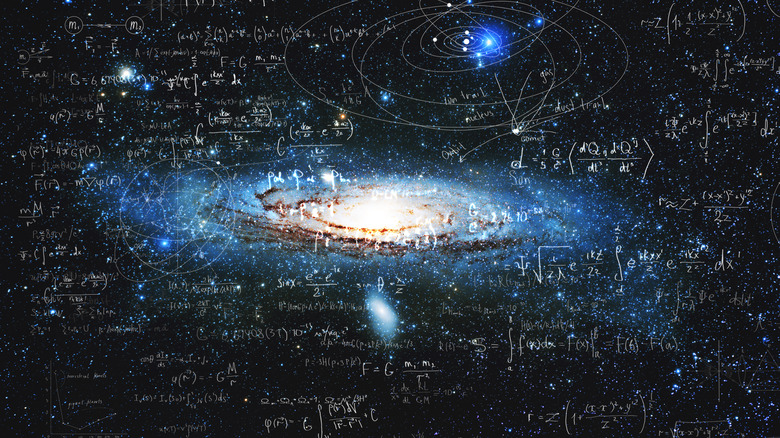What Is The Rare Earth Hypothesis?
Now that the James Webb Telescope is operational and churning out breathtaking images sure to give us a whole new perspective on our universe, the inevitable question of "are we alone in the universe?" is bound to be asked. The answer is not simple; scientists are divided on whether the third rock from the Sun is just an ordinary planet in an average solar system or if Earth and its planetary setup are genuinely unique in the vastness of space.
The Rare Earth hypothesis was first put forth in 2000 by paleontologist Peter Ward and astronomer Donald Brownlee in their book, "Rare Earth: Why Complex Life is Uncommon in the Universe." Their theory states that the celestial recipe that led to complex life here on Earth was a rare occurrence, and the chances of everything coming together at the right time, in the right place, with the right ingredients wasn't likely to happen very often in the universe.
On the flip side, you have the famed late astronomer Carl Sagan (the Neil deGrasse Tyson of his time). Sagan felt that the Earth was just another "rocky planet in a typical planetary system" situated in a mediocre area of space. He was also a proponent of extraterrestrial life. Joining Sagan on the "pro-E.T." side was Frank Drake, one of the founders of SETI (search for extraterrestrial intelligence). In 1961, Drake devised a mathematical equation called "The Drake Equation" to estimate the number of intelligent extraterrestrial civilizations that might be giving off perceivable electromagnetic signals within the Milky Way — our galaxy, not the candy bar.
Then there's The Fermi Paradox, allegedly concocted by Italian physicist Enrico Fermi, who created the first nuclear reactor and won a Nobel prize for physics.
E.T. phone home
The Fermi paradox states that if alien life exists, we should be able to see signs of their existence, because they would be so technologically advanced they could colonize the galaxy without much effort. Since we don't see any signs ... they probably don't exist. Although, Ancient Alien theorists would say otherwise.
However, according to Scientific American, not only does this "paradox" not belong to Enrico Fermi, it's not even a "paradox." The long-held belief is that, in 1950, Fermi was at lunch with colleagues wherein they were discussing a cartoon about aliens exiting a flying saucer and asked, "Where is everybody?" His colleagues said that Fermi was questioning the viability of interstellar travel, not calling into question the existence of extraterrestrial life, which is the very thing the Fermi Paradox questions. Plus, in 1950, any space travel was still far-fetched.
In 1975, astronomer Michael Hart said that if intelligent life did exist in space, they would have colonized our galaxy already. Since we don't see them, they must not be alive (via Scientific American). That statement sounds awfully familiar to Fermi's paradox.
The term "Fermi Paradox" was first used in a paper published in 1977 by physicist David Stephenson who referenced Hart's statement to answer Fermi's initial question (via Scientific American). To make things more confusing, in 1980, a physicist named Frank Tipler picked up where Hart left off, adding that any intelligent space-faring civilization would need endless resources to expand across the stars. The only way to get them was by using autonomous, intelligent, "self-replicating," terraforming machines. And since no such contraptions have ever been found, Earth is the only place with intelligent life. Again, this sounds a lot like what Fermi supposedly said.
Except... he didn't. Scientific American believes that all of this has been amalgamated into the Fermi Paradox through the cobwebs of time.
Never tell me the odds
Back to the Rare Earth hypothesis, which started with Ward and Brownlee discussing the cantina scene from the movie "Star Wars." The two believe that the events needed to create life here on Earth were so rare and unique that the idea that there's a plethora of alien life out in the cosmos (let alone all hanging out in a bar) was absurd. They listed over a dozen critical things needed for complex life to evolve here on Earth.
Most importantly, a planet must exist in the right spot, in the right galaxy. Think of it as needing a good neighborhood in the right part of town. It has to orbit around an established sun that will be there for a very long time and give off just the right amount of ultraviolet radiation to allow liquid water to form. It needs to be big enough to hold in that liquid water but also retain an atmosphere that contains the perfect amount of oxygen.
It also needs a nearby moon big enough to keep its axis tilt at just the right angle, so it has mild seasons, not wildly destructive ones.
The planet needs a molten core with enough juice to create a global magnetic field that acts like a shield against the Sun's radiation. And the one thing that might make all the difference ... active plate tectonics. Something only the Earth is thought to have. According to Ward and Brownlee, plate tectonics is responsible for creating land masses and ecosystems, keeping the surface temperature balanced, and helping curb greenhouse effects by recycling carbon in and out of the atmosphere (via Astronomy).
It sounds like the story of Goldilocks (Zone) and the Three Bears, needing things to be just right, now doesn't it? But with our Milky Way containing some 40 billion Earth-sized planets and the James Webb Telescope now peaking deeper into space, the mathematical odds of finding intelligent life out there don't seem all that bad.


